Shangri-La II 
cctv.com 03-24-2004 15:42
The road of tea and horse was a very important commercial road connecting Tibet, India, Sichuan and Yunnan Province in the old time. Today's travel destination, Deqen country, used to be a very important stop along this path.
For almost a millennium from Tang Dynasty to the 1960s, traders of tea and horses have been trudging along small passages cutting through Henduan Mountains and the Himalayas in southwest China. Unlike the Silk Road, this path, hidden away in high mountains is almost unknown to the outside world.
The tea-horse trade route branched out into two lines: the northern route extending from Ya'an in Sichuan to Qamdo in Tibet; and the southern line extending from Xishuangbanna in Yunnan to Qamdo via Dali, Lijiang, and Diqing.
The Tibetan Autonomous Prefecture of Diqing in Yunnan province used to be an important section on the southern route. Even today, porters and pilgrims from extremely isolated mountain areas still use some of the tea-horse route for transport purpose.
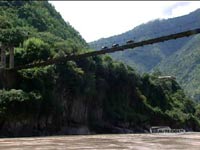
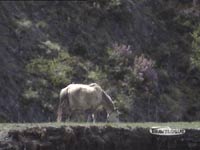

Diqing is made up of three counties, Shangri-la, Deqen, and Weixi. Sitting at the Southeast tip of Qinghai 鈥揟ibet plateau, the average elevation of the Prefecture is 3380 meters. Majestic snow-capped mountains, torrential rivers, picturesque grassland and exotic ethnic culture together make the place a paradise on earth.
It is said that the description of Shangri-la in James Hilton鈥檚 Lost Horizon was based on Diqing.
At the very north tip of Diqing prefecture lies Deqen County, a beautiful and mysterious Tibetan area. The county seat, Shenping town is less than 100 kilometers away from Tibet. Easily you can run into Tibetan caravans passing by the small town of only two main streets.
Shengping is also the highest town in Yunnan province. Because of its remote location and high altitude, it still managed to keep the original flavor of a wild Wild West small town.
Taking a stroll along the main street, you may find novelty souvenirs combing through these delightful ethnic stores.
Most people come to Deqen for one thing - to view or worship the majestic Meili Snow Mountains. Located some 10 kilometers west of Deqen county town, the mountain range includes 13 mountains all peaking over 6000 meters above sea level. Therefore, it's also known as the 13 Prince Mountains.
The main peak, Kagebo peak, towering at 6740 meters above sea level, is the highest mountain in Yunnan province, and one of the eight sacred mountains worshipped by the Tibetans. Legend has it that the peak is the incarnation of a Tibetan God who helped local people drive away evil spirit.
Each year toward the beginning of the winter, thousands of pilgrims will trek all the way from Tibet, Sichuan, Qinghai, and Gansu to pay homage to the mountain.
Kagebo peak remains mysterious and elusive to most visitors. For one thing, it's still a virgin peak; for another, it is constantly shrouded by clouds and mist.
Meili snow mountain is one of the Sacred mountains in the Tibetan area. And this year is the year of sheep, Meili mountain is also of the year of sheep. That's why many many Tibetan people come to this place and walk around the mountain from all over.
The scenery inside Meili mountain is so beautiful, you cannot imagine the major peak of the mountain is over 6000 above sea level, because here, it's almost like a tropical rainforest.
The one-hour mule-riding trip ends up at the Prince temple, a very important worshipping site of the sacred mountain for Tibetans.
Out of their journey of walking around the sacred mountain of Meili, This is a must-stop. This is the most important place to pay homage to the mountain god, this guy on the white horse.
Outside the temple, there are several huge mani mounds of colorful religious inscriptions. There are also many Tibetan pilgrims coming to walk around the mountain.
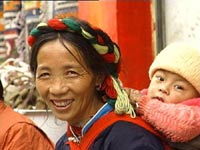
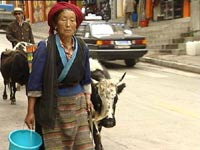
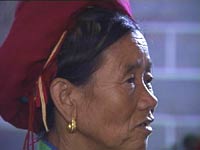
Stones are not regular stones inside the holy mountain. One piece of rock is even said to embody the wisdom of the world according to local people.
The pilgrims bring the ashes of their deceased family members here, praying for a quick and good reincarnation for them.
Those inscribed on the stone tablets and printed on the prayer flags are the six-word prayer, "omanipadmehom", "Chanting the prayer can help a person to get a good reincarnation."
The destination of my trekking is Mingyong glacier, a monsoon marine glacier.
Trekking inside Meili mountain is a pure joy. Breathing the extremely fresh air, I could almost imagine how those pilgrims feel when they walk on their spiritual journeys around the Meili mountains. There is a sense of togetherness, a perfect harmony with the Mother Nature.
The total area of Mingyong glacier is six square kilometers with an average width of 500 meters. A glacier of this size is rarely seen at such low latitude.
There are two routes of the walk around the Meili Mountain ritual: inner circle and outer circle. It takes about four to five days to complete the inner circle, and at least two weeks to finish the outer cirle.
No wonder in China we say you have to really sweat and toil to get to view the most beautiful scenery. Check that out- Mingyong glacier, spreads down from the peak of Meili snow mountain all the way down to about 2000 meters above sea level, absolutely gorgeous!
Mingyong glacier is of the lowest altitude and latitude among the modern glaciers in the world. The total length of the glacier is about 12 kilometers.
Bidding farewell to Shenping town, I headed down south along the Lancang River. Our driver Zhaxi brought me to this natural wonder - the grand Lancang Gorge cutting through Meili mountains.
Driver Zhaxi told us that local people call this gorge moon bay. In this part of Diqing the distance between the three rivers is the shortest.
Lancang River runs through Deqen county from north to south for 150 kilometers. Alongside the river, the scenery as well as the ethic culture gradually changes from north to south.
In this area, the three rives run parallel to each other within a distance of no more than 100 kilometers. But you know what, the river deltas of the three rivers, they are away from each other for over thousands of miles.
Nujiang is known as the Salween River when it flows into the ocean. Lancang River is known as the Mekong River in the west. And Golden Sand river is the upper reaches of Yangtze river.
Diqing Prefecture is in the center of the three-parallel scenic zone. We ran into droves of Tibetan pilgrims on the road along the Lancang river down south from Deqen county town.
These guys are on their way home to Chalong, a place in Tibet on the west side of Meili Mountains. I guess sometimes you don't have to talk to understand each other.
The road by Lancang River is De-wei road connecting Deqen and Weixi County. It also leads to the outer ring of walking-around Meili ritual.
Adrenaline-pumping, isn't it? This is not in some amusement park, to people in this area along Langcang River, cables are their bridges.
They can even move horses via the cables. But those cables are going to be replaced by bridges pretty soon according to local government.
Every Sunday, followers of Tibetan, Naxi and other nationalities gather at Cizhong Cathedral to pray in Tibetan language.
The construction of the Cizhong Cathedral started in 1909 and didn't complete until ten years later. Christianity was first brought to this area by a French missionary toward the end of 19th century.
Some Tibetans converted to Christians from Buddhists and passed down the tradition to the present.
In Cizhong alone, there are over 400 believers out of about 1000 people.
In addition to Christianity, the missionaries also brought something that blossoms in this mountain village: French grape.
There is a beautiful vineyard in the compound. And in this small village, almost every family grows the same kind of grape first brought over by the missionaries.
Getting out of the church, don't forget to pay a visit to Austin鈥檚 house and get a taste of his exquisite home-made wine.
Austin told me that when he started in 1997, he only made about 50 kilograms of wine. And six years later, he is making 100 times more under great demand. His family is now the only family that makes wine in the village.
The land slopes from north to south in Diqing prefecture. As we drive further down south to Weixi, the county at the south tip of Diqing. the weather gets warmer and landscape mellows down compared to the rugged mountains and gorges up north.
Weixi is the only Autonomous County of Lisu people in the country. The origin of Lisu people can be traced back to one to two thousand years ago.
Most of lisu villages are located on top of high mountains.
And the best way to reach the villages is either on foot or to ride a mule.
But don't be intimidated by the mountain climbing, with the beautiful landscape and incredibly fresh air, it's actually quite invigorating.
The destination of our mountain hiking is Tongle, a Lisu village in Yezhi district of Weixi county.
The houses in Tongle village are of typical Lisu style. They are all built of tree logs, no paint on the outside.
As usual, the hospitable people from the village put on their best clothes to greet visitors at the entrance.
Tongle is a typical lusu village of about 600 hundred people.
In Weixi County, Tongle village is known for a special ethnic dance 鈥�achimugua.
"Three-hour hiking is not a cushy job, but now I find it really worth it. Everybody in the village is out here entertaining us. And They are dancing a traditional dance of Lisu people called Achimugua."
You've probably noticed that their singing resembles the sound of goats. Actually, the dancing also imitates the movements of goats. It has something to do with Lisu's nomadic lifestyle long time ago.
Achimugua is danced on all festivals, and what they sing about varies according to the different occasion. With the sound of Achimugua reverberating over the mountain valleys, Tongle, this small, unsophisticated Lisu village along Lancang River will definitely leave every visitor with a refreshing memory.
It's interesting that although I didn't get to see the real face of Kagebo Peak; I don鈥檛 feel disappointed at all because somehow, it has already touched my heart through its beautiful and religious people. And may you have the good luck of seeing Kagebo Peak when you come and visit, Zhaxidele!
Editor:Zhang Source:CCTV.com